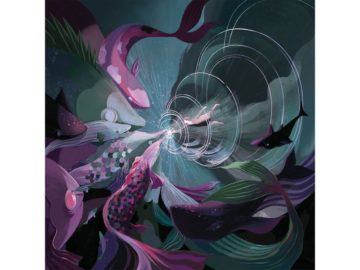Ben Goldfarb in Smithsonian:
 Among the many puzzles that confronted American sailors during World War II, few were as vexing as the sound of phantom enemies. Especially in the war’s early days, submarine crews and sonar operators listening for Axis vessels were often baffled by what they heard. When the USS Salmon surfaced to search for the ship whose rumbling propellers its crew had detected off the Philippines coast on Christmas Eve 1941, the submarine found only an empty expanse of moonlit ocean. Elsewhere in the Pacific, the USS Tarpon was mystified by a repetitive clanging and the USS Permit by what crew members described as the sound of “hammering on steel.” In the Chesapeake Bay, the clangor—likened by one sailor to “pneumatic drills tearing up a concrete sidewalk”—was so loud it threatened to detonate defensive mines and sink friendly ships.
Among the many puzzles that confronted American sailors during World War II, few were as vexing as the sound of phantom enemies. Especially in the war’s early days, submarine crews and sonar operators listening for Axis vessels were often baffled by what they heard. When the USS Salmon surfaced to search for the ship whose rumbling propellers its crew had detected off the Philippines coast on Christmas Eve 1941, the submarine found only an empty expanse of moonlit ocean. Elsewhere in the Pacific, the USS Tarpon was mystified by a repetitive clanging and the USS Permit by what crew members described as the sound of “hammering on steel.” In the Chesapeake Bay, the clangor—likened by one sailor to “pneumatic drills tearing up a concrete sidewalk”—was so loud it threatened to detonate defensive mines and sink friendly ships.
Once the war ended, the Navy, which had begun to suspect that sea creatures were, in fact, behind the cacophony, turned to investigating the problem. To lead the effort it chose a scientist who, though famous in her day, has been largely overlooked by posterity: Marie Poland Fish, who would found the field of marine bioacoustics. By the time the Navy brought her on board in 1946, Fish was already a celebrated biologist. Born in 1900, Marie Poland—known to friends as Bobbie, on account of her flapper hairstyle—grew up in Paterson, New Jersey, and was a premedical student at Smith College. Upon graduating in 1921, though, she’d turned to the sea to spend more time with Charles Fish, a young plankton scientist whom she’d met while conducting cancer research at a laboratory on Long Island. In 1923, after spending a year as Charles’ research assistant, she took a job with the U.S. Bureau of Fisheries in Massachusetts; that same year, they married.
More here.
